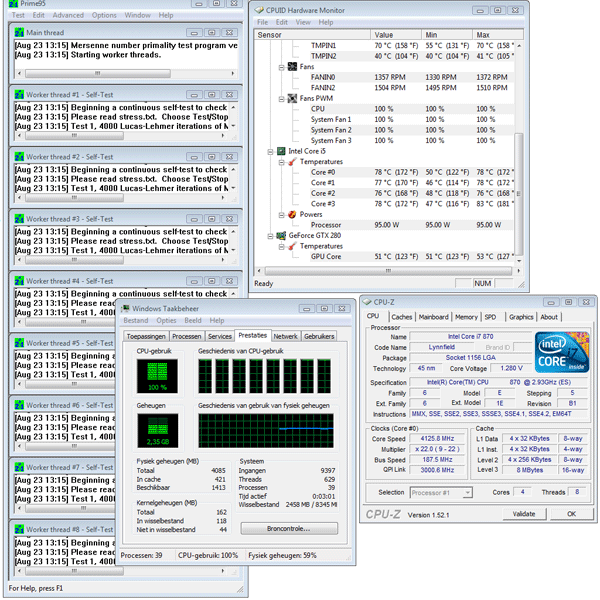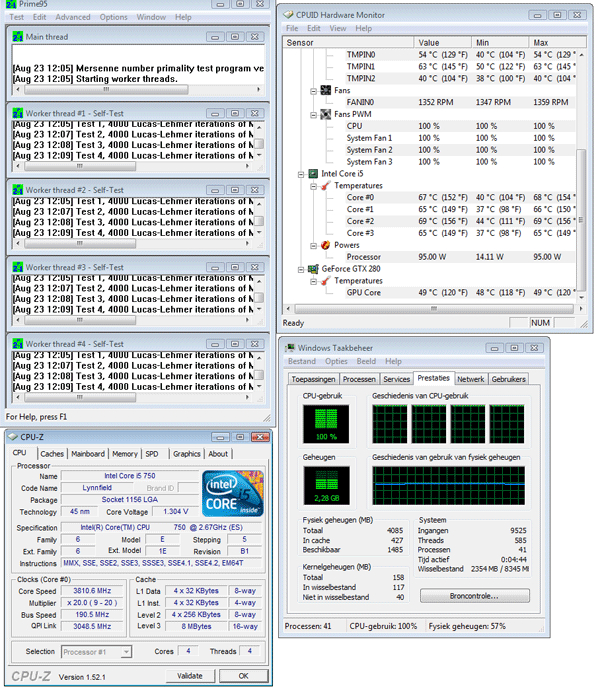Overclocking Lynnfield
Overclocking Lynnfield
With the Front Side Bus officially annihilated, things tend to change a little in the overclocking department. Only a little though. It's a little weird but the concept remains the same. In the BIOS you'll find a 133 MHz register... look at that as your 'FSB' to play around with. Of course, if you have an Extreme Edition processor, things are much easier; unfortunately this is not the case with today's launched processors.
All three processors released today are multiplier locked, meaning you select the highest possible multiplier and then increase the Bclock in the BIOS or Windows tweaking software that comes along with your motherboard.
Just play around with CPU voltages and even on the stock air cooler you can achieve some pretty snazzy results.
Core i7 870 overclocking
First up, check what your current values are. For example, say the Intel P55 mainboard applies a dynamic multiplier that would be a maximum of 133x22 which is ~ 2.9 GHz for the 870.
We were able to overclock the processor to 4.1 Ghz on the Thermalright MUX 120 air cooler. Here's what we did:
- Disable Turbo mode
- Set maximum processor multiplier
- Increase processor voltage a little bit to 1.40v
- Lower QPI ratio (as close as possible to 4800)
- Lower memory multiplier to maximum stable memory frequency
- Increase CPU base frequency
At 4000 MHz on the air cooler we easily booted into Windows. We settled at 22x187.5 @ 1.4 Volts. The end result was a stable 4125 MHz.
When we stress the CPU cores with Prime 95, temperatures now rise to 79 Degrees C (174F) which really is the maximum limit you want to go to. But... 4.1 GHz air cooled is just downright good.
Overclocking itself, it is a pretty easy thing to achieve with this processor. Mind you that overclocking will draw much power from your system.

Core i5 750 overclocking
Overclocking with the i5 750 is very similar to the i7 870. However your multiplier is again locked; the MP is 20, meaning combine that with a higher CPU base frequency and that's where your overclock is to be found.
Well, we got the CPU base frequency up-towards 190.5 MHz without too much issues. The result was an overclock the processor to 3.8 GHz on the Thermalright MUX 120 air cooler. Here's what we did:
- Disable Turbo mode
- Set maximum processor multiplier
- Increase processor voltage a little bit to 1.40v
- Lower QPI ratio (as close as possible to 4800).
- Lower memory multiplier to maximum stable memory frequency
- Increase CPU base frequency
We had to settle at at 20x190.5 @ 1.4 Volts. The result was a stable 3810MHz. Not bad for a 2.6 GHz processor air cooled. Temperatures at this stage were pretty darn good at 69 Degrees C (156F).

So it seems that Lynnfield offers plenty of overclocking ability. Mind you and I do say this strongly... you need proper equipment to overclock. Thus good memory, good power supply, great motherboard. And of course we have to mention that we received engineering samples of the processors. Vanilla samples hand-tested and selected by Intel.
Our overclocking results might differ for you and I'm sure that if you spend 30 minutes more on tweaking your results can be much higher. But from what we can tell, you'll have an awesome time overclocking the processor as the potential definitely is there.
Overclocking and power consumption
Okay, check this out then:
Power Consumption / Wattidle
100% CPU load
Core i7 870 (2930 MHz) 133x22124
162
Core i7 870 (4130 MHz) 188x22 1.425v137
295
What a lot of you do not realize that overclocking a processor can consume heaps of wattage. We put this to the test by monitoring power consumption with the processor at its default settings and then overclocked at 4.1 GHz. The results are flabbergasting, when we stress the 4 (8 threaded) CPU cores 100% at default (Turbo on) we peak at only 162 Watts.
Once we overclock to 4.1 GHz... the power consumption all of a sudden is 295 Watts (!), so an additional 1200 MHz of power is costing us an additional 133 Watts.
Stuff to think about before you start to overclock as that is almost silly.
